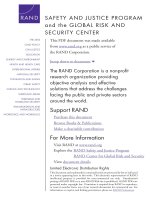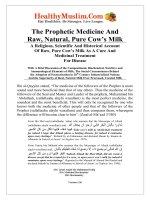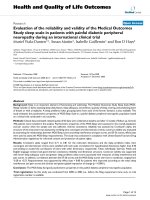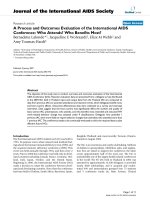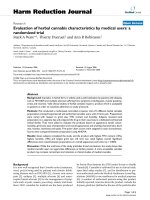Evaluation of the outcomes of treating pituitary tumor by rotating gamma knife at the Nuclear Medicine and Oncology Center, Bachmai hospital
Bạn đang xem bản rút gọn của tài liệu. Xem và tải ngay bản đầy đủ của tài liệu tại đây (147.98 KB, 6 trang )
Journal of military pharma-medicine no6-2017
EVALUATION OF THE OUTCOMES OF TREATING PITUITARY TUMOR
BY ROTATING GAMMA KNIFE AT THE NUCLEAR MEDICINE AND
ONCOLOGY CENTER, BACHMAI HOSPITAL
Nguyen Thi Minh Phuong*; Mai Trong Khoa**
Doan Van De***; Tran Quoc Hung*
Summary
Objectives: To evaluate treatment outcomes of rotating Gamma knife radiosurgery (RGKR)
for pituitary adenomas at the Nuclear Medicine and Oncology Center, Bachmai Hospital.
Subjects and methods: A prospective interventional study was conducted on 48 patients, who
were treated with rotating Gamma knife for pituitary tumor. All patients had size of tumor < 5 cm
on MRI and recruited in between April, 2008 and April, 2016. Results: Male/female ratio was
1/2, patient age ranged from 21 - 78 years old with median of 44.58 ± 12.84 years old. Clinical
symptoms were reduced gradually after radiosurgery: the percentage of patients with headache
symptom at baseline after the time of 6 months, 12 months, 24 months and 36 months
accounted for 70.8%, 50%, 36.4%, 20.5% and 8.6%, respectively. Abnormal hormone level had
been improved after radiosurgery. Size of the tumor was reduced. Severe side effects or death
were not reported in the follow-up period. Conclusion: Radiosurgery with rotating Gamma knife
is an effective and safe treatment method for pituitary tumor.
* Keywords: Pituitary tumor; Rotating Gamma knife; Outcomes.
INTRODUCTION
The pituitary gland tumors are tumors
that occur in the anterior pituitary, which
account for 10 - 15% of the intracranial
tumors, more than 99% of the pituitary
tumors are benign tumors and grow
slowly. Pituitary tumors are mainly seen in
adults, very rarely seen before puberty,
and the incidence rate of men compared
to women is 1/2. Different methods for
treatment of pituitary tumors are available
such as surgery, medicine, radiation therapy,
and radiotherapy by rotating Gamma
knife. The main purpose of these methods
is to remove or inhibit tumor growth, to
maintain the endocrine function of the
pituitary gland, to suppress or reduce the
secretion of hormones caused by tumors,
and with minimum of invasion to the
surrounding areas. In previous decades,
* 198 Hospital
** Bachmai Hospital
*** 103 Hospital
Conresponding author: Nguyen Thi Minh Phuong ()
Date received: 20/04/2017
Date accepted: 25/07/2017
169
Journal of military pharma-medicine no6-2017
treatment of pituitary tumors was mainly
with medications. When medical treatment
fails, surgery may be performed to open
the cranium but it was done only in some
major hospitals with high rate of postoperative
complications and the mortality rate over
10%. In recent decades, surgical removal
of the tumor by endoscopy through the
sinus fracture has partially reduced the
mortality rate [1, 2] but the rate of
recurrence after surgery is still high.
Globally, the application of rotating Gamma
knife for treatment is widely accepted in
the United States, Japan, Singapore, France,
Hungary... [3, 4, 5, 6]. Since 2007, the
American rotating Gamma knife system
has been introduced at the Center for
Nuclear Medicine and Oncology, Bachmai
Hospital for the treatment of brain tumors
and some cranial diseases including pituitary
tumors. This treatment method is less
invasive, requires no anesthesia, with less
complication rate and short hospital stay.
In Vietnam, there has been no studies
evaluating the role of rotating Gamma
knife for the treatment of pituitary tumors.
Therefore, this study aims to: Evaluate
the treatment results of pituitary tumors by
rotating Gamma knife at the Center of
Nuclear Medicine and Oncology, Bachmai
Hospital.
SUBJECTS AND METHODS
1. Subjects.
* Inclusion criteria:
The study enrolled 48 patients aged
≥ 18 years diagnosed with pituitary tumor
based on cranial MRI and treated with
rotating Gamma knife at the Center for
Nuclear Medicine and Oncology, Bachmai
Hospital from April, 2008 to April, 2016.
170
* Exclusion criteria:
- Patients with other endocrine diseases
such as Basedow disease, adrenal tumors...
- Patients taking prolonged steroids,
pregnant women, breast-feeding women.
- Patients < 18 years old.
2. Research methods.
Interventional study with repeatedmeasures analysis.
* Study procedures:
- Baseline evaluations:
+ Record clinical and laboratory information
in study case report forms.
+ Clinical: functional and physical
symptoms.
+ Para-clinical tests: hormone levels,
size and nature of tumors on brain MRI.
- Steps for conducting the operation:
+ Step 1: prepare the patient.
+ Step 2: fix the patient's head using
the Fraim frame.
+ Step 3: MRI simulation.
+ Step 4: plan the radiosurgery.
+ Step 5: proceed with radiotherapy.
- Post-treatment evaluation: based on
clinical and paraclinical symptoms of the
patient being examined, compared before
and after treatment.
+ Clinical characteristics: age, sex, history
of treatment, clinical symptoms before
treatment and 6 months, 12 months, 24
months and 36 months after treatment.
+ Clinical features:
. Evaluation of size, nature and extent
of invasive on MRI before treatment,
Journal of military pharma-medicine no6-2017
6 months, 12 months, 24 months, 36 months
after treatment.
. Hormonal tests: PRL, GH, ACTH, LH,
TSH, FSH before treatment, 6 months,
12 months, 24 months, 36 months after
treatment.
+ Patients underwent pituitary hormone
quantification using morning venous blood
(fasting condition).
+ Investigation of TSH, FSH, PRL, ACTH,
LH, GH... by electrochemistry immunoassay
on Elecsys 2010 with Roche reagent at
Biochemistry Department, Bachmai Hospital.
* Data analysis and processing:
The collected information is encrypted
and processed on SPSS 16.0 software.
RESULTS AND DISCUSSIONS
1. Patient disposition by age group.
18 - 30 years old: 4 patients (8.3%);
31 - 45 years old: 21 patients (43.8%);
46 - 60 years old : 16 patients (33.3%);
> 60 years old: 7 patients (14,6%).
The study on 48 patients with pituitary
tumors using rotating Gamma radiography
at the Center for Nuclear Medicine and
Oncology, Bachmai Hospital showed that:
The majority of patients in the age group
of 31 - 45 years old, the lowest age was
21, the highest age was 78, the average
was 44.58 ± 12.84 years old. The percentage
of male accounted for 33.3%; females
accounted for 66.7%.
2. Distribution of patients by gender.
Figure 1: Patient distribution.
In the study group, the proportion of
male patients was 33.3% male, female
was 66.7%. Heng Wan's study (2007) [3]
reported that the average age of patients
with pituitary tumors was 44.58 ± 12.84
years old and the proportion of women
was higher than men.
3. Medical history before surgery.
No interventions: 6 patients
medication
interventions:
30
(12.5%);
patients
(62.5%); surgical interventions: 12 patients
(25.0%).
Most patients have received medication
or surgical treatment for recurrence. 12.5%
of the patients who received no treatment
were indicated to use radiotherapy.
According to Faglia G, 92% of patients
with pituitary gland tumors who had been
treated with Gamma irradiation had failed
to response to prior medication treatments.
171
Journal of military pharma-medicine no6-2017
4. Irradiation dosages.
Table 1:
Dose (Gy)
Mean dose (X)
Standard deviation
(SD)
Min
Max
Gamma knife group (n = 48)
13.6
2.2
11
22
Hormonally active (n = 21)
14.0
2.9
11
22
Clinically non-functioning
(n = 27)
13.3
1.3
12
16
Group
p
> 0.05
The mean surgical irradiation dose of 13.6 ± 2.2 Gy. The dose was used in the
hormonally active group was higher than that in the hormonally non-active group, but
the difference was not statistically significant (p > 0.05).
5. Time to follow-up after surgery.
Table 2:
Follow-up time (month)
Value
Mean (X ± SD)
38.9 ± 10.9
Minimum
12
Maximum
63
The mean postoperative follow-up time was 38.9 ± 10.9 months (from 12 months to
63 months) after radiosurgery. We found that all of the clinical signs of postoperative
irradiation were significantly improved.
6. Clinical symptoms before and after the radiosurgery.
Table 3:
Symptoms
(n = 48)
Baseline
(n = 48)
6 months
(n = 46)
n
12 months
(n = 44)
%
n
24 months
(n = 39)
%
n
%
36 months
(n = 35)
n
%
n
%
Headache
34
70.8
23
50
16
36.4
8
20.5
3
8.6
Visual disturbance
25
52.1
17
37.0
10
22.7
7
17.9
6
17.1
Libido
6
12.5
6
13.3
2
4.4
2
4.8
1
2.7
Menstrual disorder
10
20.8
11
23.9
5
11.4
5
12.5
4
11.4
Lactation
8
16.7
6
13.0
2
4.5
2
5.1
0
0
Clinical symptoms decreased over time. Headache was one of the most common
symptoms before treatment (70.8% of patients) and this had decreasead to 50%,
36.4%, 20.5%, and 8.6% after 6, 12, 24, and 36 months, respectively. The study on
172
Journal of military pharma-medicine no6-2017
over 270 patients of Sheehan J.P (2011) [5] showed that rotating Gamma kife
treatment improved functional symptoms in 90% of patients and 55% of them improved
their physical symptoms.
7. Tumor size (on MRI) before and after the radiosurgery.
Table 4:
Baseline
(n = 48)
6 months
(n = 46)
12 months
(n = 44)
24 months
(n = 39)
36 months
(n = 35)
20.9 ± 10.3
19.5 ± 11.5
15.6 ± 12.3
12.9 ± 12.7
12.9 ± 12.4
Minimum tumor size (mm)
7
0
0
0
0
Maximum tumor size (mm)
48
48
48
50
50
Time-points
Mean tumor size (mm)
Mean tumor size decreased after treatment, significantly decreased after 12 months
compared with pretreatment, difference was statistically significant (p < 0,05). Heng
Wan et al (2002) [3] showed that the percentage of patients with tumor size decreased
or remained constant after tumor resection was 89.7%.
8. Hormone level before and after treatment.
Table 5:
Baseline
36 months after treatment
Hormon level
Mean
SD
Medium
Mean
SD
Medium
TSH (uU/mL)
3.647
14.224
1.500
1.941
1.141
1.840
LH (mU/mL)
5.97
2.72
5.42
6.09
2.75
5.49
FSH (mU/mL)
10.92
15.55
7.02
8.63
7.61
6.72
Prolactin (ng/mL)
62.27
115.03
12.45
29.99
75.78
13.42
GH (ng/mL)
11.31
24.38
2.35
2.83
1.95
2.19
ACTH (Pg/mL)
27.04
18.95
20.97
25.62
9.81
23.41
The post-treatment hormone levels decreased, especially PRL and GH, these levels
significantly decreased and difference was statistically significant (p < 0.01). LH, ACTH,
THS and FSH levels were not significantly reduced (p > 0.05). This was probably due
to the fact that the number of patients with ACTH, TSH, LH and FSH hypersecretion
was not significant. Shota Tanaka et al (2010) [6] reported that after the radiotherapy,
the PRL concentration decreased from 88.4 ng/mL to 28.4 ng/mL. The difference was
statistically significant (p = 0.001). There was no cases of death after treatment.
173
Journal of military pharma-medicine no6-2017
CONCLUSION
The study on 48 patients with pituitary
tumors using rotating Gamma radiosurgery
at the Center for Nuclear Medicine and
Oncology, Bachmai Hospital:
- Patient age ranged from 21 - 78 years
old with average of 44.58 ± 12.84 years old.
- Male/female ratio was 1/2.
- Clinical symptoms were reduced
gradually after radiosurgery: the percentage
of patients with headache symptom at the
time point of baseline, after 6 months, 12
months, 24 months, 36 months accounted
for 70.8%, 50%, 36.4%, 20.5% and 8.6%,
respectively.
- Abnormal hormone level GH, PRL
had been improved after radiosurgery.
- Size of the tumor was reduced.
- Severe side effects or death were not
reported in the follow-up period.
- Radiosurgery with rotating Gamma
knife has been shown as an effective and
safe treatment method for pituitary tumor.
REFERENCES
1. Nguyễn Đức Anh. Nhận xét đặc điểm
lâm sàng, cận lâm sàng và đánh giá kết quả
174
phẫu thuật u tuyến yên tăng tiết prolactin.
Luận văn Tốt nghiệp Bác sỹ Nội trú Chuyên
ngành Ngoại khoa. Trường Đại học Y Hà Nội.
2012.
2. Lý Ngọc Liên. Nghiên cứu áp dụng
phương pháp mổ u tuyến yên qua đường
xoang bướm tại Bệnh viện Việt Đức từ 2000 2002. Luận văn Tốt nghiệp Bác sỹ Chuyên
khoa Cấp II. Đại học Y Hà Nội. 2003.
3. Heng Wan. Gamma knife radiosurgery
for secretory pituitary adenomas: experience
in 347 consecutive cases. 2007, 106 (6),
pp.980-987.
4. Faglia G. Genesis of pituitary adenomas,
in Landolt A Vance M.L, Reilly P.L. Pituitary
adenoma. New York, Churchill Livingstone.
1996.
5. Sheehan J.P, Pouratian N, Steiner L,
Laws E.R, Vance M.L. Gamma knife surgery
for pituitary adenomas. Factors related
to radiological and endocrine outcomes.
Department of Neurological Surgery, University
of Virginia Health System, Charlottesville,
Virginia 22908, USA. 2011.
6. Shota Tanaka1, Michael J.Link. Gamma
knife radiosurgery for patients with prolactinsecreting pituitary adenomas. World Neurosurgery.
2010, 74 (1), pp.147-152.
